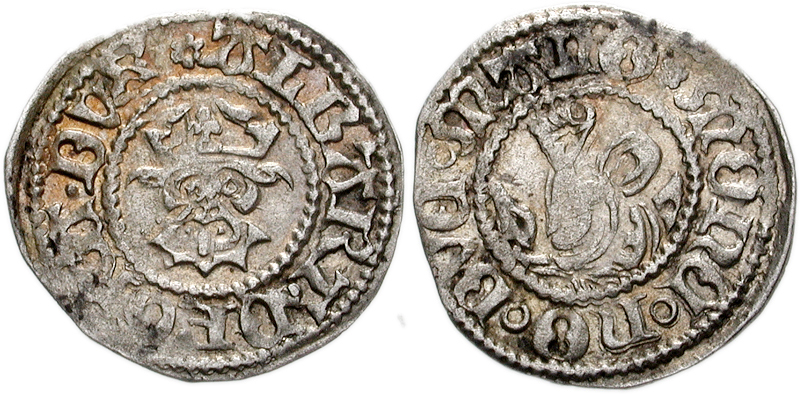Dreiling (coin) on:
[Wikipedia]
[Google]
[Amazon]
 Dreiling (also ''Dreyling'', ''Dreling'' or ''Driling'', Latin ''ternarius'', Danish ''trepenning'') was the name of a type of fiat coin called a '' Scheidemünze'' that was worth three ''pfennigs''.
Coins of the ''Dreiling'' type were first minted after 1374 in
Dreiling (also ''Dreyling'', ''Dreling'' or ''Driling'', Latin ''ternarius'', Danish ''trepenning'') was the name of a type of fiat coin called a '' Scheidemünze'' that was worth three ''pfennigs''.
Coins of the ''Dreiling'' type were first minted after 1374 in
 Dreiling (also ''Dreyling'', ''Dreling'' or ''Driling'', Latin ''ternarius'', Danish ''trepenning'') was the name of a type of fiat coin called a '' Scheidemünze'' that was worth three ''pfennigs''.
Coins of the ''Dreiling'' type were first minted after 1374 in
Dreiling (also ''Dreyling'', ''Dreling'' or ''Driling'', Latin ''ternarius'', Danish ''trepenning'') was the name of a type of fiat coin called a '' Scheidemünze'' that was worth three ''pfennigs''.
Coins of the ''Dreiling'' type were first minted after 1374 in Lübeck
Lübeck (; Low German also ), officially the Hanseatic City of Lübeck (german: Hansestadt Lübeck), is a city in Northern Germany. With around 217,000 inhabitants, Lübeck is the second-largest city on the German Baltic coast and in the stat ...
and a little later in Hamburg
Hamburg (, ; nds, label=Hamburg German, Low Saxon, Hamborg ), officially the Free and Hanseatic City of Hamburg (german: Freie und Hansestadt Hamburg; nds, label=Low Saxon, Friee un Hansestadt Hamborg),. is the List of cities in Germany by popul ...
. After the treaty (''Rezess'') of 1392, it was a coin in the Wendish Coinage Union
The Wendish Coinage Union (''Wendischer Münzverein'') was an organisation bound by treaty formed by the North German Hanseatic towns from 1379 to the 16th century whose aim was to have standardised coinage regulations.
The core cities involved ...
. The participating cities of Lübeck, Hamburg, Lüneburg
Lüneburg (officially the ''Hanseatic City of Lüneburg'', German: ''Hansestadt Lüneburg'', , Low German ''Lümborg'', Latin ''Luneburgum'' or ''Lunaburgum'', Old High German ''Luneburc'', Old Saxon ''Hliuni'', Polabian ''Glain''), also calle ...
, Rostock
Rostock (), officially the Hanseatic and University City of Rostock (german: link=no, Hanse- und Universitätsstadt Rostock), is the largest city in the German state of Mecklenburg-Vorpommern and lies in the Mecklenburgian part of the state, ...
and Wismar
Wismar (; Low German: ''Wismer''), officially the Hanseatic City of Wismar (''Hansestadt Wismar'') is, with around 43,000 inhabitants, the sixth-largest city of the northeastern German state of Mecklenburg-Vorpommern, and the fourth-largest city ...
agreed on a uniform appearance for the ''Dreilings''. It depicted the coat of arms of the respective city on both sides. Weight and silver content were also standardised. Some towns in Mecklenburg
Mecklenburg (; nds, label=Low German, Mękel(n)borg ) is a historical region in northern Germany comprising the western and larger part of the federal-state Mecklenburg-Western Pomerania. The largest cities of the region are Rostock, Schwer ...
, Pomerania
Pomerania ( pl, Pomorze; german: Pommern; Kashubian: ''Pòmòrskô''; sv, Pommern) is a historical region on the southern shore of the Baltic Sea in Central Europe, split between Poland and Germany. The western part of Pomerania belongs to t ...
and in Denmark
)
, song = ( en, "King Christian stood by the lofty mast")
, song_type = National and royal anthem
, image_map = EU-Denmark.svg
, map_caption =
, subdivision_type = Sovereign state
, subdivision_name = Kingdom of Denmark
, establishe ...
minted ''Dreilings'' without being a member of the Union.
After the dissolution of the Wendish Coinage Union in the middle of the 16th century, ''Dreilings'' continued to be minted in northern Germany until the middle of the 19th century, and were made of copper from the end of the 18th century. Schleswig-Holstein
Schleswig-Holstein (; da, Slesvig-Holsten; nds, Sleswig-Holsteen; frr, Slaswik-Holstiinj) is the northernmost of the 16 states of Germany, comprising most of the historical duchy of Holstein and the southern part of the former Duchy of Sc ...
struck the last ''Dreiling'' in 1850/51 from copper and Hamburg in 1855 from a billon alloy
Billon () is an alloy of a precious metal (most commonly silver, but also gold) with a majority base metal content (such as copper). It is used chiefly for making coins, medals, and token coin
In numismatics, token coins or trade tokens ar ...
.
Occasionally, the copper 1 ''pfennig'' coins of the 18th century were also referred to as ''Dreilinge'', since they were worth 3 '' Hellers'' (''Dreyheller'').
See also
* Dreier - a Saxon coin worth 3 groschen, later a Prussian-German coin worth 3 pfennigsReferences